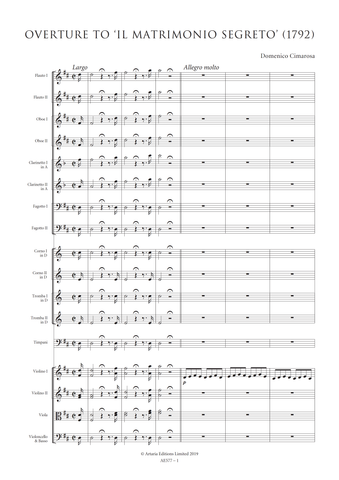Details
|
Not only is Il matrimonio segreto (The Secret Marriage) the best-known and most popular of all Cimarosa's theatrical creations, it is also one of the most popular - if not the most popular - opera buffa of all time. Given its prima in Vienna exactly two months after Mozart's death, it enjoyed a greater success at the time than any of Mozart's operas with the possible exception of Cos fan tutte. By the end of the 18th century, Il matrimonio segreto had received over 70 performances in Vienna alone and was still being presented in that city in 1884 when Hanslick wrote that the work was "full of sunshine - it had that genuine light golden colour which is the only fitting one for musical comedy".
The opera reached international fame outside Vienna immediately, being presented within two years of its prima in Leipzig, Dresden, Berlin, Paris, Milan, Florence, Naples, Turin,Madrid and Lisbon. By the mid-19th century it had been performed in German, French, Spanish, Danish, Swedish, Polish, Dutch, Russian, English and Czech; the opera reached Calcutta in 1870.
Today at least 25 18th-century manuscript copies of the full score are extant, located in the libraries of such diverse cities as Brussels, Paris, Dresden, St Petersburg, London and Prague in addition to such 18th-century manuscript copies as may be found in Italy in the conservatory libraries of Genoa, Florence (two copies), Milan (two copies), Parma and Rome. Domenico Cimarosa's original holograph score in his own handwriting (except for the recitatives which are in another hand, a standard practice with Cimarosa), is to be found, along with most of the other holograph copies of his operas, in the library of the Conservatorio di musica S Pietro a Majella, Naples (Rari 1-5-16,17). In addition to this original score in the composer's hand at the Naples Conservatory, there are three 18th-century manuscript copies of the opera in this Neapolitan library: Rari cornicione 179 (which omits trumpets and the timpani of the original Cimarosa score), 181 (which omits timpani but includes clarini, probably meant as clarinets rather than trumpets in this instance), and 183 (which omits trumpets and timpani).
From all these existing 18th-century manuscript copies of the score, two well-known versions of the opera's Overture emerge; the first of some 425 bars (the version published by Carisch in 1940 and Ricordi in 1976), and one of some 360 bars in length, the one found in the three manuscript copies found in the library of the conservatory in Naples. The Introduction and Exposition of both versions are the same, but there are substantial differences in the Development section.
It is quite surprising to discover that Cimarosa's own original score for Vienna (Rari 1-5-16,17) should have neither of these two well-known versions of the Overture, but one of some 373 bars which is outstandingly different and published here for the first time. In addition to a Principal Subject (the only theme in the two known editions), Cimarosa provides a hauntingly beautiful oboe melody as a contrasting Second Theme. This, in turn, changes the structure of the Development and Recapitulation sections from those of the two better-known forms of the Overture. Why this second theme has been omitted in all the known 18th century manuscript copies as well as the 20th-century printed editions is a matter for speculation. Did the impresarios want a 'tighter' overture than the one Cimarosa originally provided, having their copyists make such a major change? Did these impresarios feel that the overture to a comic opera would be more appropriate with only the opening, lively theme in D major? Did the composer himself think that changes were appropriate after hearing his original version performed in Vienna? This editor feels the latter case is unlikely since no copy exists in Cimarosa's hand of the two well-known and well-established versions, and Cimarosa undoubtedly conducted from the keyboard many re-stagings of his most successful opera and had the opportunity, had he wanted it, of sketching out an altered version. (It is known for a fact that Cimarosa conducted some of the Neapolitan porformances and made changes in the lyrical passages of the opera for these stagings). Herein is now published for the first time, Domenico Cimarosa's original version of the Overture to Il matrimonio segreto as performed at the Hoftheater in Vienna on 7 February 1792.
As is the case with all Cimarosa's autograph material the overture to Il matrimonio segreto shows signs of having been composed at breakneck speed. Every conceivable notational shortcut is taken and his placement of articulation and dynamic markings is erratic. It has been necessary, therefore, to frequently interpret the composer's intentions and even at times to impose an editorial solution where his own thoughts are not clear. In making sense of Cimarosa's score the style and notation of articulation and dynamic markings have been largely standardised throughout, and, where missing, markings have been reconstructed from parallel passages. These are indicated by the use of dotted slurs or brackets where appropriate. Obvious wrong notes have been corrected without comment; editorial emendations with no authority from the source are placed within brackets.
Nick Rossi
|














